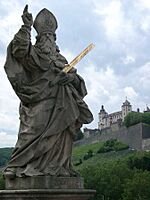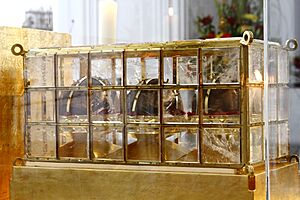Saint Kilian facts for kids
Quick facts for kids SaintKilian |
|
|---|---|

Statue of Saint Kilian
in Würzburg, Germany |
|
| Apostle to the Franconians | |
| Born | 640 Cloughballybeg, Mullagh, Ireland |
| Died | 8 July 689 Würzburg, Franconia, Bavaria |
| Venerated in | Roman Catholic Church Eastern Orthodox Church |
| Feast | 8 July |
| Attributes | wearing a bishop's mitre and wielding a sword |
| Patronage | sufferers of rheumatism |
Saint Kilian (also known as Cillian or Killian) was an Irish missionary and bishop. He is famous for bringing Christianity to Franconia, a region that is now part of northern Bavaria, Germany. He started his work there in the late 600s. People celebrate his feast day on July 8.
Contents
Who Was Saint Kilian?
Saint Kilian was born in Ireland around the year 640. He came from a noble family. Some stories say he was a monk at a famous monastery called Hy, which is now known as Iona. He began his studies in Rosscarbery, County Cork, and finished them in Tuosist, County Kerry.
In the summer of 686, Kilian and eleven friends traveled to Rome. They wanted to get permission from the Pope to become missionaries. They met with Pope Conon in late autumn. From Rome, they went to the castle of Würzburg. This castle was home to the East Frankish ruler, Duke Gozbert. At that time, Gozbert and his people were not Christians.
The group of missionaries then split up. Some went to find other places to work. Kilian stayed in Würzburg with two friends: a priest named Colmán and a deacon named Totnan. Kilian made Würzburg the center of his work. He spread Christianity across a growing area in East Franconia and Thüringen (Thuringia). He helped Duke Gozbert and many of his people become Christians.
The Death of Saint Kilian
Kilian told Duke Gozbert that his marriage was against Christian teachings. The Duke was married to his brother's widow, a woman named Geilana. Kilian had tried to convince Geilana to become a Christian, but she refused.
When Geilana heard Kilian's words about her marriage, she became very angry. While the Duke was away, she sent her soldiers to the main square of Würzburg. Kilian and his friends were preaching there. Geilana's soldiers then killed Kilian and his two companions, Colmán and Totnan, by beheading them.
Honoring Saint Kilian
Burchard was the first bishop of Würzburg. He was chosen by Boniface. Burchard built a cathedral where Kilian and his friends were believed to have died. He had their remains dug up and buried inside a special vault in the cathedral.
Today, the skulls of Kilian, Colmán, and Totnan are still kept. They are decorated with precious stones. On Saint Kilian's Day, a glass case holding the three skulls is taken from a crypt. It is paraded through the streets of Würzburg. Many people come to see it. The skulls are then displayed in Würzburg Cathedral, which is dedicated to Kilian. You can also see statues of these three saints on the famous Saints' Bridge over the Main River.
Patronage and Special Days
Saint Kilian is known as a patron saint for people who suffer from rheumatism.
He is also the patron saint of the parish of Tuosist in County Kerry, Ireland. It is believed he lived there before traveling to Germany. A church and a holy well in Tuosist are named after him. On his feast day, July 8, people traditionally visit the well for prayers. This is followed by social events in the evening.
Kilian is also the patron saint of Paderborn, Germany.
How Saint Kilian is Shown
Saint Kilian is usually shown wearing a bishop's mitre (a special hat). He also holds a sword. The sword represents how he died, as he was killed with a sword. You can see this in his statue in Würzburg.
Saint Kilian's Legacy
The Kiliani-Volksfest is a big festival in the Würzburg region of Germany. It lasts for two weeks every July. It is both a civil and religious celebration.
Many places are named after Saint Kilian:
Churches
- St. Kilian's Church, Heilbronn in Heilbronn, Germany
- Saint Kilian Catholic Church in Mission Viejo, California, USA
- Saint Kilian Catholic Church in Farmingdale, New York, USA
Monasteries
- St. Kilian's Abbey, Würzburg
Schools
- St Killian's College in Garron Tower, Northern Ireland
- The German School in Dublin, Ireland, is named after Saint Kilian. This honors the early connections in education between Ireland and Germany.
- St. Kilian Catholic Basic School in Awutu Breku, Ghana
- St. Kilian Catholic Junior High School in Obutu, Ghana
Towns
Other Places
- The St. Kilian's Heritage Centre is in Mullagh, County Cavan, Ireland. It opened in 1995. The local community and the Diocese of Würzburg helped build it. The center has many items and copies related to the saint.
See also
- Kilianstein


